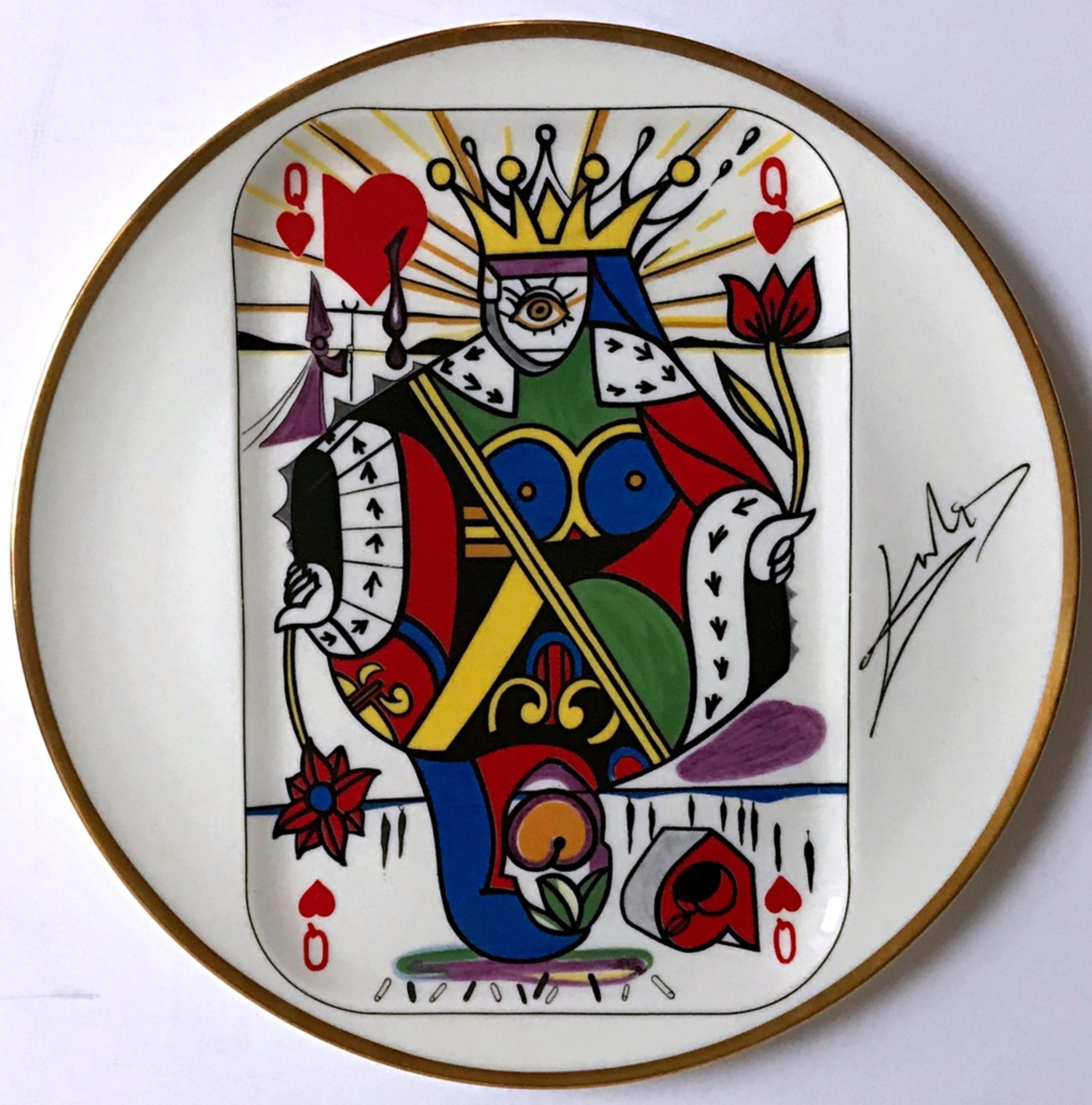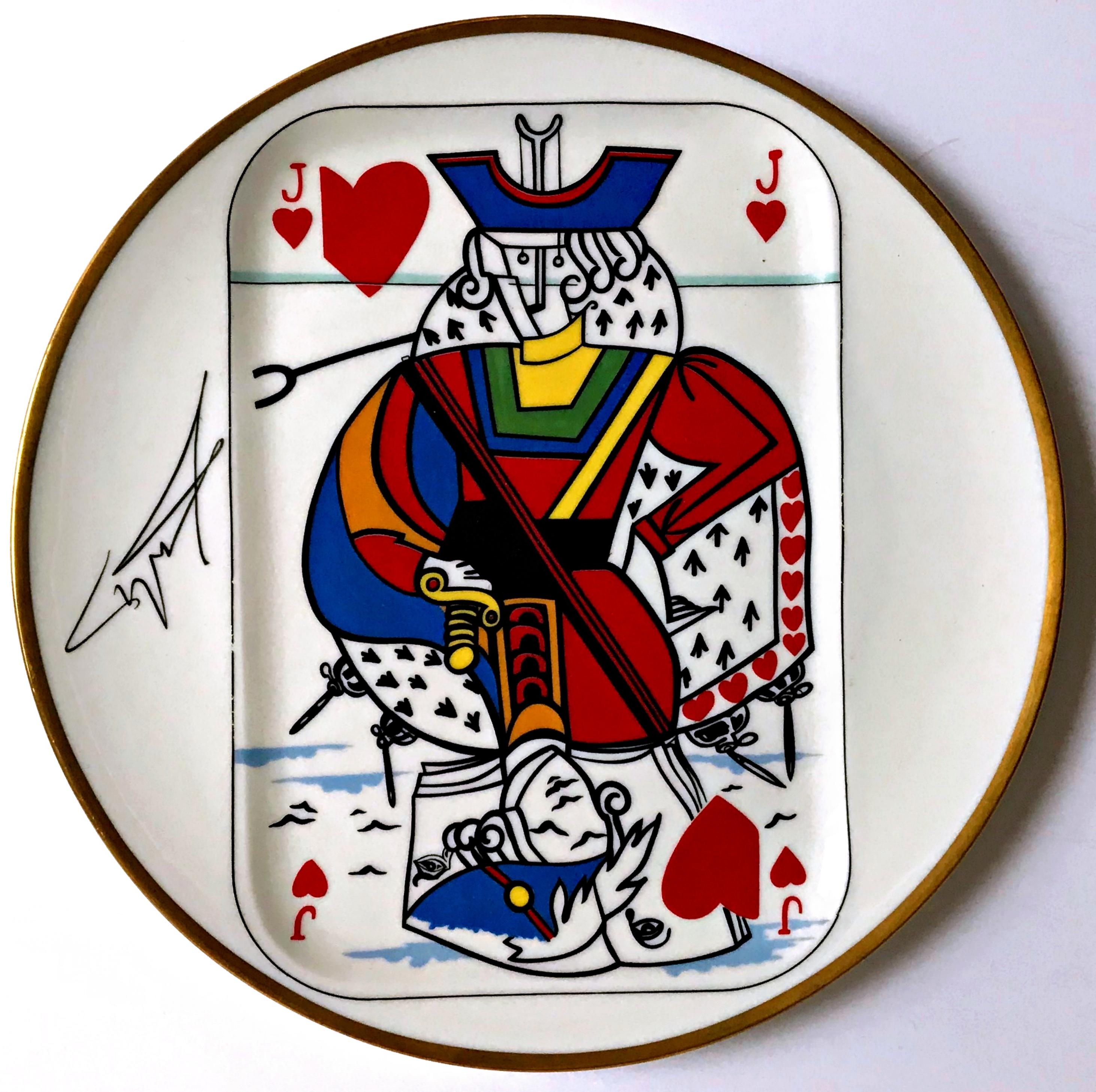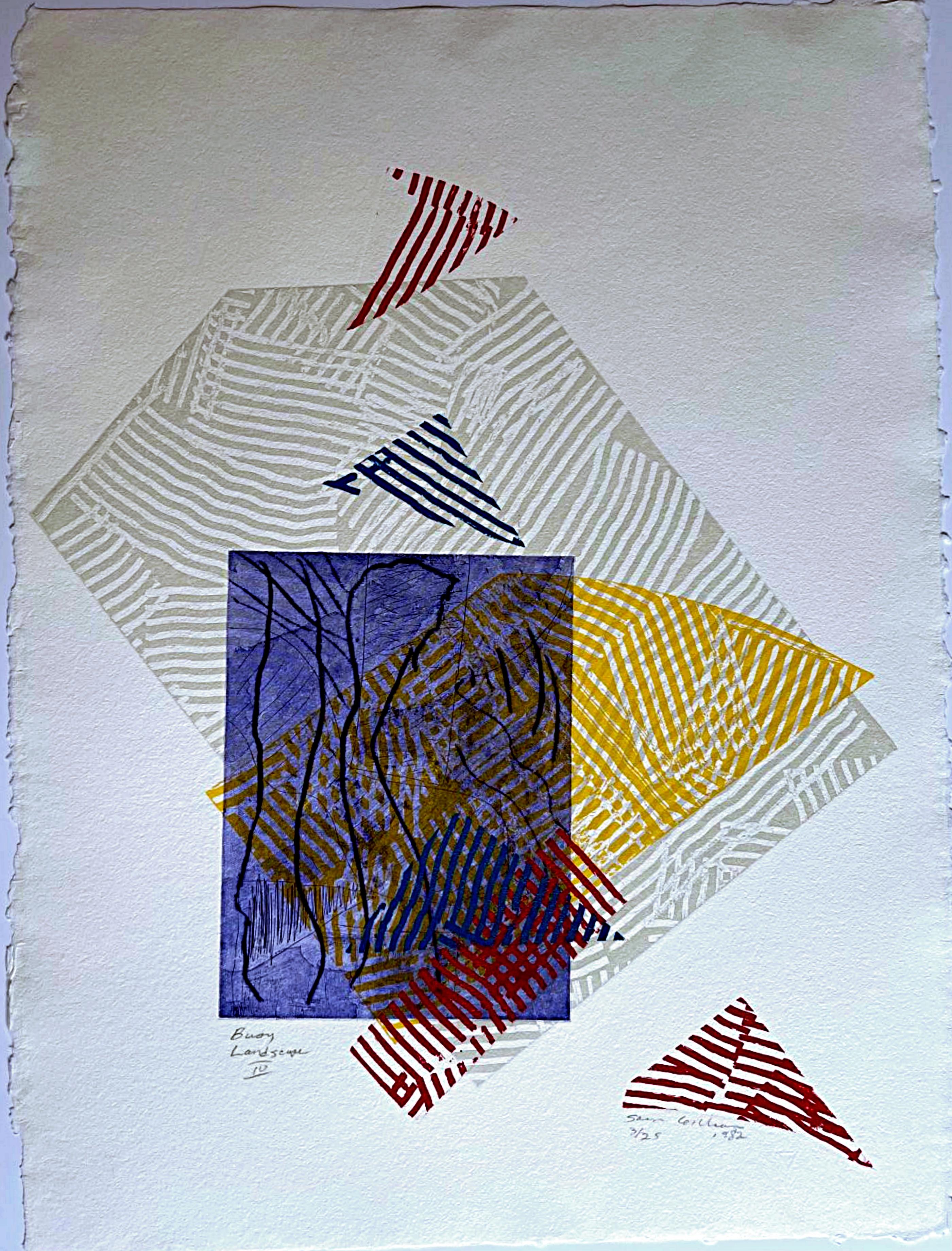Items Similar to Two Hands, Mid Century Surrealist mixed media Signed/N (Gemini 20 Anselmino 61)
Want more images or videos?
Request additional images or videos from the seller
1 of 9
Man RayTwo Hands, Mid Century Surrealist mixed media Signed/N (Gemini 20 Anselmino 61) 1966
1966
About the Item
MAN RAY
Two Hands, 1966
Mixed Media: Silkscreen on Plexiglass
Published by Gemini GEL
Measurements:
Image: 20"h x 16"w
sheet plexi: 25.5"h x 19.5"w
overall (with frame): 26.75"h x 20.75"w.
Edition 3/40
Hand signed by the artist on the lower right recto and numbered on the front lower left "3/40". Sheet stamped w/ copyright, date and logo
Frame included: held in original vintage metal frame on plexiglass
Provenance: Acquired from a sale to benefit the Di Rosa Art Park (Napa, California)
This coveted original signed, limited edition silkscreen and plexiglass is entitled "Hands" (MR66-1195) and is hand signed by the artist on the front lower right. It was created in 1966 and is numbered on the front lower left "3/40", from the total limited edition of only 40 impressions. What's very appealing about this work is that the the image is on plexiglass, which is then framed. We have placed a white background under it for the photography, but the actual work is on clear plexiglass.Very desirable and collectible Man Ray piece. Uncommon.
literature: Gemini 20 Anselmino 61
“I am working directly with light itself.”
- Man Ray
More about Man Ray:
“I have finally freed myself from the sticky medium of paint, and am working directly with light itself.” 1 So enthused Man Ray, born Emmanuel Radnitzky, in 1922, shortly after his first experiments with camera-less photography. He remains well known for these images, commonly called photograms but which he dubbed “rayographs” in a punning combination of his own name and the word “photograph.”
Man Ray’s artistic beginnings came some years earlier, in the Dada movement. Shaped by the trauma of World War I and the emergence of a modern media culture—epitomized by advancements in communication technologies like radio and cinema—Dada artists shared a profound disillusionment with traditional modes of art making and often turned instead to experimentations with chance and spontaneity. In The Rope Dancer Accompanies Herself with Her Shadows, Man Ray based the large, color-block composition on the random arrangement of scraps of colored paper scattered on the floor. The painting evinces a number of interests that the artist would carry into his photographic work: negative space and shadows; the partial surrender of compositional decisions to accident; and, in its precise, hard-edged application of unmodulated color, the removal of traces of the artist’s hand. 2
In 1922, six months after he arrived in Paris from New York, Man Ray made his first rayographs. To make them, he placed objects, materials, and sometimes parts of his own or a model's body onto a sheet of photosensitized paper and exposed them to light, creating negative images. This process was not new—camera-less photographic images had been produced since the 1830s—and his experimentation with it roughly coincided with similar trials by Lázló Moholy-Nagy. But in his photograms, Man Ray embraced the possibilities for irrational combinations and chance arrangements of objects, emphasizing the abstraction of images made in this way. He published a selection of these rayographs—including one centered around a comb, another containing a spiral of cut paper, and a third with an architect’s French curve template on its side—in a portfolio titled Champs délicieux in December 1922, with an introduction written by the Dada leader Tristan Tzara. In 1923, with his film Le Retour à la raison (Return to Reason), he extended the rayograph technique to moving images.
Around the same time, Man Ray’s experiments with photography carried him to the center of the emergent Surrealist movement in Paris. Led by André Breton, Surrealism sought to reveal the uncanny coursing beneath familiar appearances in daily life. Man Ray proved well suited to this in works like Anatomies, in which, through framing and angled light, he transformed a woman’s neck into an unfamiliar, phallic form. He contributed photographs to the three major Surrealist journals throughout the 1920s and 1930s, and also constructed Surrealist objects like Gift, in which he altered a domestic tool (an iron) into an instrument of potential violence, and Indestructible Object (or Object to Be Destroyed), a metronome with a photograph of an eye affixed to its swinging arm, which was destroyed and remade several times.
Working across mediums and historical movements, Man Ray was an integral part of The Museum of Modern Art’s exhibition program early on. His photographs, paintings, drawings, sculptures, films, and even a chess set were included in three landmark early exhibitions: Cubism and Abstract Art (1936); Fantastic Art, Dada, Surrealism (1936–37), for which one of his rayographs served as the catalogue’s cover image; and Photography, 1839–1937 (1937). In 1941, the Museum expanded its collection of his work with a historic gift from James Thrall Soby, an author, collector, and critic (and MoMA trustee) who had, some eight years earlier, acquired an expansive group of Man Ray’s most important photographs directly from the artist. Within this group were 24 first-generation, direct, unique rayographs from the 1920s that speak to Man Ray’s ambition, as he wrote in 1921, to “make my photography automatic—to use my camera as I would a typewriter.” 3
Natalie Dupêcher independent scholar, 2017 (Courtesy MOMA)
- Creator:Man Ray (1890 - 1976, American)
- Creation Year:1966
- Dimensions:Height: 27 in (68.58 cm)Width: 21 in (53.34 cm)Depth: 0.5 in (1.27 cm)
- Medium:
- Movement & Style:
- Period:
- Condition:artwork itself is in very good condition; in original vintage period metal frame.
- Gallery Location:New York, NY
- Reference Number:1stDibs: LU1745213068032
About the Seller
5.0
Platinum Seller
These expertly vetted sellers are 1stDibs' most experienced sellers and are rated highest by our customers.
Established in 2007
1stDibs seller since 2022
289 sales on 1stDibs
Typical response time: 1 hour
- ShippingRetrieving quote...Ships From: New York, NY
- Return PolicyA return for this item may be initiated within 1 day of delivery.
More From This SellerView All
- Hotel du Nord (Little Durer)By Joseph CornellLocated in New York, NYJoseph Cornell Hotel du Nord (Little Durer), 1972 Silkscreen in five colors with varnish and stencil additions printed on Buff Arches Paper Pencil signed and annotated Artists Proof ...Category
1970s Surrealist Abstract Prints
MaterialsScreen, Varnish, Stencil, Mixed Media
- Queen of Hearts vintage French limited edition numbered porcelain ceramic plateBy Salvador DalíLocated in New York, NYSalvador Dali Queen of Hearts, 1967 Limited Edition Limoges Porcelain Plate. Signature Fired into Plate. Numbered with COA 9 3/4 inches diameter Edition 358/2000 Artist Signature and edition Fired into Plate on front. Certificate of Authenticity with edition number from the manufacturer. Produced by Puiforcat, France This dazzling limited edition 1967 Salvador Dali porcelain plate...Category
1960s Surrealist Abstract Prints
MaterialsPorcelain, Mixed Media, Archival Paper, Screen
- Alphabet Pour Adultes (Alphabet For Adults) Silkscreen, lithograph Signed FramedBy Man RayLocated in New York, NYMan Ray Alphabet Pour Adultes (Alphabet For Adults), 1970 Silkscreen in colors and lithograph on paper mounted on wood veneer mounted on card stock. Hand Signed. Numbered. Dated. Ha...Category
1970s Surrealist Figurative Prints
MaterialsLithograph, Screen, Mixed Media, Pencil
- Buoy Landscape IV, Mixed media signed/n limited edition Ab Ex relief printBy Sam GilliamLocated in New York, NYSam Gilliam Buoy Landscape IV, 1982 Color relief print, etching, screenprint, drypoint, aquatint and roulette all from deeply etched copper plates, on handmade wove paper 31 1/2 × 24...Category
1980s Abstract Expressionist Abstract Prints
MaterialsMixed Media, Pencil, Graphite, Drypoint, Etching, Aquatint, Screen
- Deluxe Signed Edition of Film Festival Lincoln Center (Feldman & Schellmann, II.By Andy WarholLocated in New York, NYAndy Warhol Deluxe Signed Edition of Film Festival Lincoln Center (Feldman & Schellmann, II.19), 1967 Silkscreen, die-cut on opaque acrylic Edition 2/200 (Signed and numbered on the back with engraving pen) Hand-signed by artist, As this work was done on acrylic, Warhol signed and numbered it by hand on verso with an engraving needle. Stamped and dated with copyright Frame included: Elegantly framed in a museum quality wood frame with UV plexiglass. A die-cut window has been created in the back of the frame to reveal Warhol's incised signature and edition Publisher: Leo Castelli, New York Printer: Chiron Press, New York Catalogue Raisonne: Feldman & Schellmann, II.19 This work is often hung and displayed both vertically and horizontally - see photos for inspiration This work is one of only 200 done on opaque acrylic rather than wove paper, signed and numbered on the opaque acrylic by Andy Warhol with an engraving pen. (Separately, there was an unsigned edition of 500 on wove paper). What distinguishes this rare, extremely desirable signed edition of 200, other than that it is signed and numbered by hand by Andy Warhol, is that the black graphic text FIFTH NEW YORK is placed directly over the text Film Festival of Lincoln Center; whereas in the edition of 500, the text black text FIFTH NEW YORK is placed on top of the white text. An innovative feature that appears in this special edition is a perforated line running across the surface of the print, at its triangular cut out sides, mimicking the tear line present in real commercial movie admissions tickets. Chiron Press commissioned by Lincoln Center, devised a special process expressly to imprint the edition with this perforation using a die cut stamp. This work is quintessential early Warhol, with characteristic bright neon colors, featuring text, along with the artist's very recognizable flower motif. The Lincoln Center ticket simultaneously reflects Warhol's central preoccupations with commercial culture (the ticket is, par excellence, an object that is bought and sold), as well as his fascination with Hollywood - as the ticket, quite literally, represents an entree into the world of film. Warhol's appropriation of the flower - an otherwise sentimental and decorative motif, transforming it into a symbol of the Pop Art movement, is a hallmark of his early style and innovations. Andy Warhol's vibrant vintage color silkscreen Lincoln Center Ticket from the fabulous Sixties is considered one of the more iconic and recognizable Warhol images. It is also one of Warhol's earliest prints. The Vera List...Category
1960s Pop Art Abstract Prints
MaterialsPlexiglass, Screen, Engraving, Mixed Media
- Jack of Hearts - limited edition porcelain plate made in FranceBy Salvador DalíLocated in New York, NYSalvador Dali Jack of Hearts, 1967 Limited Edition Limoges Porcelain Plate. Signature Fired into Plate. Numbered with COA 9 3/4 × 9 3/4 × 3/10 inches 24.8 × 24.8 × 0.8 cm Edition 35...Category
Mid-20th Century Surrealist Mixed Media
MaterialsCeramic, Screen, Porcelain
You May Also Like
- Cuzco, Contemporary digital artwork, computational engraving on aluminum, greensBy Matteo MauroLocated in Dallas, TX"Cuzco" is a contemporary green and cool toned artwork computationally engraved on aluminium. It is part of a pair, and can each be sold separately. Artist Matteo Mauro...Category
2010s Contemporary Abstract Prints
MaterialsMetal
- Peruvian Streams, abstract digital artwork in blues, engraved on aluminumBy Matteo MauroLocated in Dallas, TXPeruvian Stream is a contemporary blue toned artwork computationally engraved on aluminium. It is part of a pair, and each can be sold separately. Artist Matteo Mauro...Category
2010s Contemporary Abstract Prints
MaterialsMetal
- Forbidden Fruit: EveBy Jolynn ReigeluthLocated in Kansas City, MOArtist : Jolynn Reigeluth Title : Forbidden Fruit: Eve Materials : Etching, collage and watercolor Date : 2018 Dimensions : 19" x 13" in. Jolynn Reige...Category
2010s Surrealist Mixed Media
MaterialsPrinter's Ink, Watercolor, Color, Etching, Monoprint
- Dedication–Lincoln Center (B.App.23)By Robert MotherwellLocated in London, GB44.5 x 29.25 ins (113 x 74.3 cms) Edition of 108 Signature:Signed "R. Motherwell" in pencil lower left Inscriptions:Numbered in pencil lower left; some impressions have artist's chop mark lower left Publisher:The Juilliard School...Category
1960s Abstract Expressionist Abstract Prints
MaterialsColor, Mixed Media, Screen
- Rampant Slip, 2017. Series of 15 unique printsLocated in Tuscany, PisaFull title: Rampant Slip— Danced Himself to Death [MJ] for the future of r---e---a---l---l--y REAL un-freedom One of fifteen unique screenprints and monoprints with artist applied v...Category
2010s Contemporary Abstract Prints
MaterialsMonoprint, Screen
- Nebula 1 - Contemporary print, Abstraction, Acrylic on paperLocated in Warsaw, PLMARIANNA STUHR Graduated from Faculty of Graphic Art at Academy of Fine Arts in Cracow as well as doctoral studies at Academy of Fine Arts in Warsaw. For a few years, she works in fi...Category
2010s Abstract Mixed Media
MaterialsPaper, Acrylic, Screen





